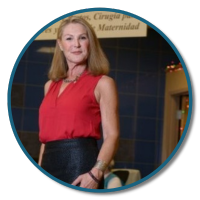Interview with Charis Ober
Discover the inspiration behind Cord Blood in the Classroom, an educational program from Save the Cord Foundation. In an exclusive interview, Charis Ober, Founder and Executive Director of Save the Cord Foundation, shares insights on introducing high school and university students to the science of cord blood stem cells and exploring career opportunities in this exciting field of medicine. Q: Tell me how "Cord Blood in the Classroom" came about. A: We know it is important to educate people about the benefits of cord blood before they have a baby, and we saw the benefits of educating younger people. We have been visiting local high schools and educating students about the benefits of cord blood for a few years now, but we wanted to do more. We decided to develop a platform to reach as many students as possible and to standardize the material to be efficient. It was designed to be easily incorporated into the classroom with different modules and activities as a 'click and play' lesson. We are very fortunate to have the support of the Arizona Department of Health Services and the Arizona Public Cord Blood Program to help this project come to fruition. Q: What is the launch date? A: November 15th, 2024 which is also World Cord Blood Day. Q: Will this be a requirement or elective for the students in Arizona? A: This material is not officially part of the curriculum at the schools. The information is science-based, but it also highlights the different careers involved in working with cord blood including doctors, nurses, laboratory staff, policy makers, and couriers. Q: Who/What was instrumental in the development of this program?
A: Critical contributors include Lead Architect - Melanie Hall; Dr. Maegan Capitano, Assistant Professor of Microbiology & Immunology at Indiana University School of Medicine; the Save the Cord Foundation Interns; Barbara Torrey, Clarissa Monreal, and the high school students from Gilbert Public Schools; Rachel Manley, Director of Global Outreach at Save The Cord Foundation. Q: How long did it take to develop?
A: It took under 2 years to develop. Q: Who is your target audience?
A: The program is targeting high school and university students currently, but the material may also be appropriate for advanced middle school students. The team is also exploring ways to expand the program for older healthcare professionals such as nurses. The program was developed with teachers in mind, however, requiring no prior knowledge of cord blood. Q: What do you hope participants will gain from the program?
A: We hope the participants have a clear understanding of the science of cord blood stem cells and the related career opportunities within this growing field of medicine. Q: What is your favorite part of the content?
A: The video of a cord blood collection process which is part of the core lesson presented by Dr. Maegan Capitano. Q: What were some of your challenges when developing it?
A: It was challenging to develop the material in a multi-dimensional way to help the teachers use it in the classroom and to hold the attention of the learners. It was edited down quite a bit to simplify the lessons and to be age-appropriate for the target audience. Q: Is this content available to everyone and what is the cost?
A: Yes, it is available to everyone and it's free! Q: What do you want to see happen after it is launched?
A: We are the first state to launch a school program, and we plan to expand across the entire state of Arizona. We would love for it to be used across the United States and worldwide. Q: What lessons did you learn from the process?
A: Because the content discusses possible career paths, the teachers and school districts support it. Also, the students love the interactive escape room and survivor stories. Q: What is next for "Cord Blood in the Classroom"?
A: We have ideas for adding other modules and content to the existing platform. We also plan to have other versions available for different target audiences and in other languages.
View the official press release from Save the Cord Foundation here.
|
